Related Research Articles
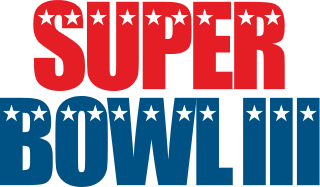
Super Bowl III was an American football game played on January 12, 1969, at the Orange Bowl in Miami, Florida. It was the third AFL–NFL Championship Game in professional American football, and the first to officially bear the trademark name "Super Bowl". Super Bowl III is regarded as one of the greatest upsets in both American football history and in the history of professional sports. The 19 1⁄2- points underdog American Football League (AFL) champion New York Jets defeated the National Football League (NFL) champion Baltimore Colts by a score of 16–7.
The second AFL–NFL World Championship Game was an American football game played on January 14, 1968, at the Orange Bowl in Miami, Florida. The National Football League (NFL)'s defending champion Green Bay Packers defeated American Football League (AFL) champion Oakland Raiders by the score of 33–14. This game and the following year's are the only two Super Bowls played in the same stadium in consecutive seasons.
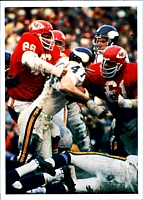
Super Bowl IV was an American football game played on January 11, 1970, at Tulane Stadium in New Orleans, Louisiana. It was the fourth and final AFL–NFL World Championship Game in professional football prior to the AFL–NFL merger taking effect the following season. The American Football League (AFL) champion Kansas City Chiefs defeated the National Football League (NFL) champion Minnesota Vikings by the score of 23–7. This victory by the AFL squared the Super Bowl series with the NFL at two games apiece as the two leagues merged after the game.
Super Bowl VIII was an American football game between the National Football Conference (NFC) champion Minnesota Vikings and the American Football Conference (AFC) champion Miami Dolphins to decide the National Football League (NFL) champion for the 1973 season. The Dolphins conquered the Vikings by the score of 24–7 to win their second consecutive Super Bowl, the first team to do so since the Green Bay Packers in Super Bowls I and II, and the first AFL/AFC team to do so.
Super Bowl XI was an American football game between the American Football Conference (AFC) champion Oakland Raiders and the National Football Conference (NFC) champion Minnesota Vikings to decide the National Football League (NFL) champion for its 1976 season. The Raiders defeated the Vikings by the score of 32–14 to win their first Super Bowl. The game was played on January 9, 1977, at the Rose Bowl in Pasadena, California. This remains the earliest scheduled calendar date for a Super Bowl; and the most recent Super Bowl to begin before 4:00 p.m. ET.
Daryle Pasquale Lamonica was an American professional football quarterback who played in the American Football League (AFL) and the National Football League (NFL) for 12 seasons, primarily with the Oakland Raiders. Lamonica was drafted by the NFL Green Bay Packers in round 12 with the 168th overall pick. He spent his first four seasons mostly as a backup for the Buffalo Bills, who selected him in the 24th round of the 1963 AFL Draft. Lamonica played his next eight seasons as the primary starter of the Raiders, including after they joined the NFL through the AFL–NFL merger.
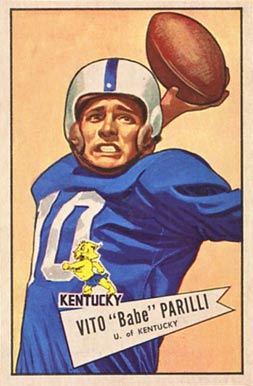
Vito "Babe" Parilli was an American football quarterback and coach who played professionally for 18 seasons. Parilli spent five seasons in the National Football League (NFL), three in the Canadian Football League (CFL), and 10 in the American Football League (AFL). He played college football at the University of Kentucky, where he twice received consensus All-American honors and won two consecutive bowl games.

Leonard Ray Dawson was an American football quarterback who played in the National Football League (NFL) and American Football League (AFL) for 19 seasons, primarily with the Kansas City Chiefs franchise. After playing college football at Purdue, Dawson began his professional career with the NFL in 1957, spending three seasons with the Pittsburgh Steelers and two with the Cleveland Browns. He left the NFL in 1962 to sign with the AFL's Chiefs, where he spent the last 14 seasons of his career, and rejoined the NFL after the AFL–NFL merger.

Frederick Biletnikoff, nicknamed "Scarecrow", is an American former football player and coach. He played as a wide receiver for the Oakland Raiders in the American Football League (AFL) and National Football League (NFL) for fourteen seasons and later was an assistant coach with the team. He retired as an NFL player after the 1978 season, and then played one additional season in the Canadian Football League (CFL) for the Montreal Alouettes in 1980. While he lacked the breakaway speed to be a deep-play threat, Biletnikoff was one of the most sure-handed and consistent receivers of his day, with a propensity for making spectacular catches. He was also known for running smooth, precise pass routes. He is a member of both the Pro Football Hall of Fame (1988) and College Football Hall of Fame (1991).
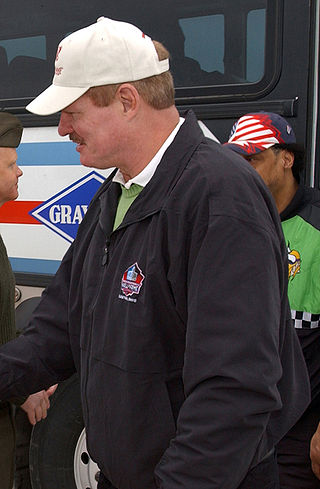
Theodore Paul Hendricks, nicknamed "the Mad Stork," is a former professional American football linebacker who played for 15 seasons with the Baltimore Colts, the Green Bay Packers, and the Oakland / Los Angeles Raiders in the National Football League (NFL).
David John Casper nicknamed "the Ghost", is an American former professional football tight end who played in the National Football League (NFL), primarily with the Oakland Raiders. Casper has been inducted into both the College Football Hall of Fame (2012) and the Pro Football Hall of Fame (2002).

William Ferdie Brown was an American professional football player, coach and administrator. He played as a cornerback for the Denver Broncos and the Oakland Raiders of the American Football League (AFL) and later in the National Football League (NFL). Following his playing career, Brown remained with the Raiders as an assistant coach. He served as the head football coach at California State University, Long Beach in 1991, the final season before the school's football program was terminated. Brown was inducted into the Pro Football Hall of Fame as a player in 1984. At the time of his death he was on the Raiders' administrative staff.
For its first nine seasons, 1960 through 1968, the American Football League determined its champion via a single playoff game between the winners of its two divisions.
Clarence Eugene Davis is an American former professional football player who was a running back for eight seasons with the Oakland Raiders of the National Football League (NFL) from 1971 to 1978. He played college football for the USC Trojans. He won an NFL championship with the Raiders, winning Super Bowl XI.
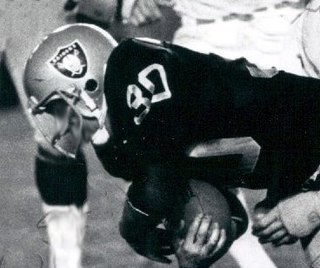
Mark van Eeghen is an American former professional football player who was a running back for ten years in the National Football League (NFL), during which he made two Super Bowl appearances. He played eight seasons for the Oakland Raiders (1974–1981) and then two seasons with the New England Patriots (1982–1983). Van Eeghen rushed for over 1,000 yards in three consecutive seasons from 1976 to 1978.
William Joseph Miller is an American former professional football player who was a wide receiver for six seasons in the American Football League (AFL). He played college football for the Miami Hurricanes. He played in the AFL for the Dallas Texans (1962), the Buffalo Bills (1963), and the Oakland Raiders (1964–1968).
James Davis "Country" Warren was a collegiate halfback and professional football cornerback who played twelve seasons with the American Football League's San Diego Chargers and Miami Dolphins and the NFL's Oakland Raiders.
Robert Hardy "Bake" Turner is an American former professional football player who was a wide receiver in the National Football League (NFL) and American Football League (AFL). He played college football at Texas Technological College, then professionally for nine seasons. He was with the AFL's New York Jets, where in 1963 he replaced Art Powell who had been traded to the Oakland Raiders. He was a member of the Jets' AFL and Super Bowl III teams after the 1968 season, and also played for the Baltimore Colts and Boston Patriots of the NFL.
The 1967 AFL Championship Game was the eighth American Football League championship game, played on December 31 at Oakland-Alameda County Coliseum in Oakland, California.
The 1968 AFL Championship Game was the ninth annual title game of the American Football League, played on December 29 at Shea Stadium in Queens, New York City, New York. In a rematch of the notorious Heidi Game played earlier in the season, the New York Jets (11–3) of the Eastern Division hosted the defending champion Oakland Raiders (12–2) of the Western Division. Although the Raiders had the better record, the Jets were slight favorites. The Raiders had hosted a tiebreaker playoff game the week before against the Kansas City Chiefs (12–2) to determine the Western Division champion, while the Eastern champion Jets won their division outright and thus were idle.
References
- 1 2 "Banazak [sic], of Crivitz, Carries Top Rushing Average of Oakland Backs". The Post-Crescent. January 14, 1968. p. 33. Retrieved November 21, 2014– via Newspapers.com.

- ↑ "Pete Banaszak College Stats, School, Draft, Gamelog, Splits". College Football at Sports-Reference.com. Retrieved 2024-03-24.
- ↑ "'It's like heaven:' Banaszak's best memories in football are of the Super Bowl | St. Augustine Record". Archived from the original on 2017-02-06.